Paper Menu >>
Journal Menu >>
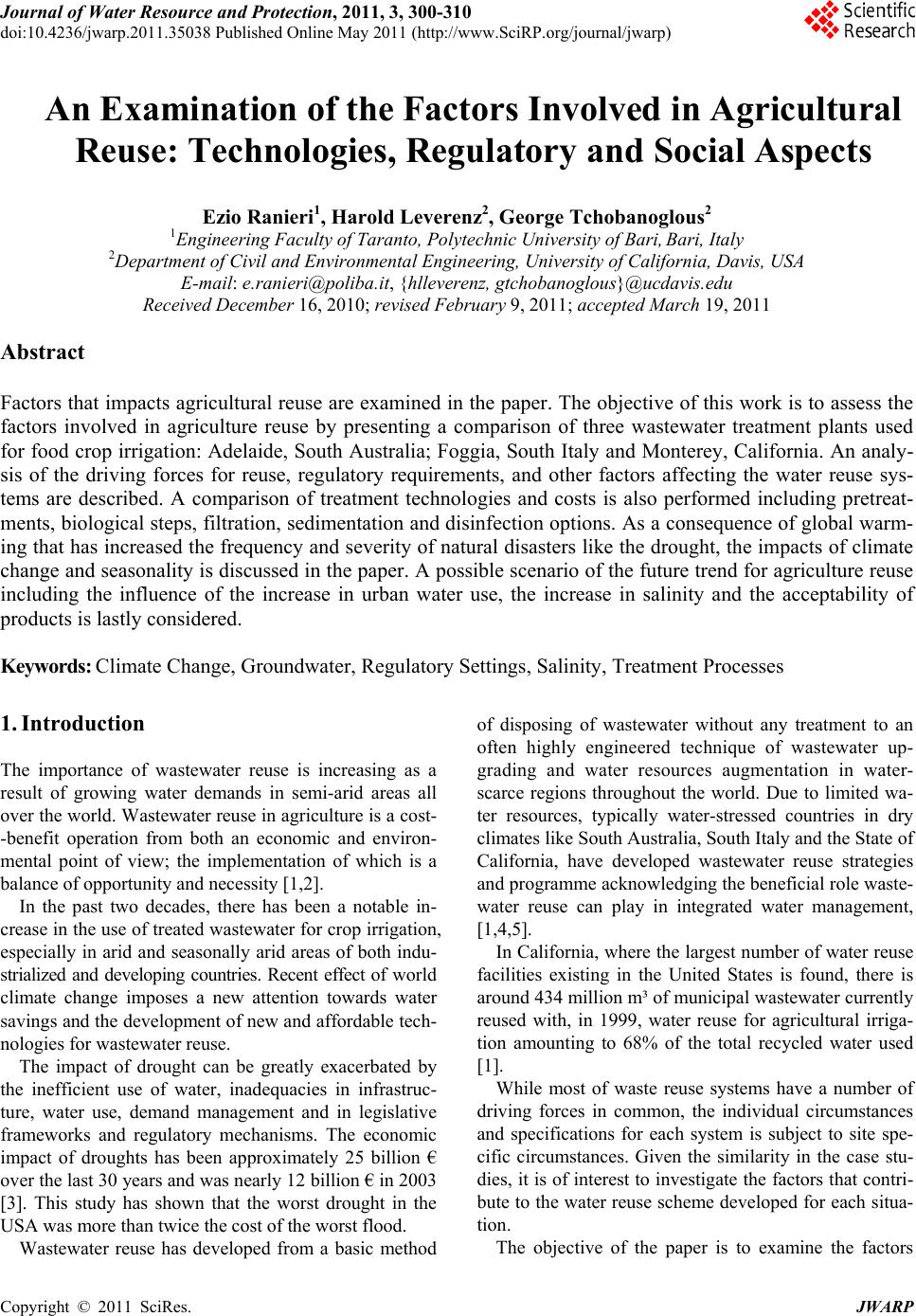 Journal of Water Resource and Protection, 2011, 3, 300-310 doi:10.4236/jwarp.2011.35038 Published Online May 2011 (http://www.SciRP.org/journal/jwarp) Copyright © 2011 SciRes. JWARP An Examination of the Factors Involved in Agricultural Reuse: Technologies, Regulatory and Social Aspects Ezio Ranieri1, Harold Leverenz2, George Tchobanoglous2 1Engineering Faculty of Taranto, Polytechnic University of Bari, Bari, Italy 2Department of Civil and Environmen tal Engineering, University of California, Davis, USA E-mail: e.ranieri@poliba.it, {hlleverenz, gtchobanoglous}@ucdavis.edu Received December 16, 2010; revised February 9, 2011; a ccepted Ma r ch 19, 201 1 Abstract Factors that impacts agricultural reuse are examined in the paper. The objective of this work is to assess the factors involved in agriculture reuse by presenting a comparison of three wastewater treatment plants used for food crop irrigation: Adelaide, South Australia; Foggia, South Italy and Monterey, California. An analy- sis of the driving forces for reuse, regulatory requirements, and other factors affecting the water reuse sys- tems are described. A comparison of treatment technologies and costs is also performed including pretreat- ments, biological steps, filtration, sedimentation and disinfection options. As a consequence of global warm- ing that has increased the frequency and severity of natural disasters like the drought, the impacts of climate change and seasonality is discussed in the paper. A possible scenario of the future trend for agriculture reuse including the influence of the increase in urban water use, the increase in salinity and the acceptability of products is lastly considered. Keywords: Climate Change, Groundwater, Regulatory Settings, Salinity, Treatment Processes 1. Introduction The importance of wastewater reuse is increasing as a result of growing water demands in semi-arid areas all over the world. Wastewater reuse in agriculture is a cost- -benefit operation from both an economic and environ- mental point of view; the implementation of which is a balance of opport uni t y and necessity [1,2]. In the past two decades, there has been a notable in- crease in the use of treated wastewater for crop irrigation, especially in arid and seasonally arid areas of both indu- strialized and developing countries. Recent effect of world climate change imposes a new attention towards water savings and the development of new and affordable tech- nologies for wastewater reuse. The impact of drought can be greatly exacerbated by the inefficient use of water, inadequacies in infrastruc- ture, water use, demand management and in legislative frameworks and regulatory mechanisms. The economic impact of droughts has been approximately 25 billion € over the last 30 years and was nearly 12 billion € in 2003 [3]. This study has shown that the worst drought in the USA was more than twice the cost of the worst flood. Wastewater reuse has developed from a basic method of disposing of wastewater without any treatment to an often highly engineered technique of wastewater up- grading and water resources augmentation in water- scarce regions throughout the world. Due to limited wa- ter resources, typically water-stressed countries in dry climates like South Australia, South Italy and the State of California, have developed wastewater reuse strategies and programme acknowledging the beneficial role waste- water reuse can play in integrated water management, [1,4,5]. In California, where the largest number of water reuse facilities existing in the United States is found, there is around 434 million m³ of municipal wastewater currently reused with, in 1999, water reuse for agricultural irriga- tion amounting to 68% of the total recycled water used [1]. While most of waste reuse systems have a number of driving forces in common, the individual circumstances and specifications for each system is subject to site spe- cific circumstances. Given the similarity in the case stu- dies, it is of interest to investigate the factors that contri- bute to the water reuse scheme developed for each situa- tion. The objective of the paper is to examine the factors 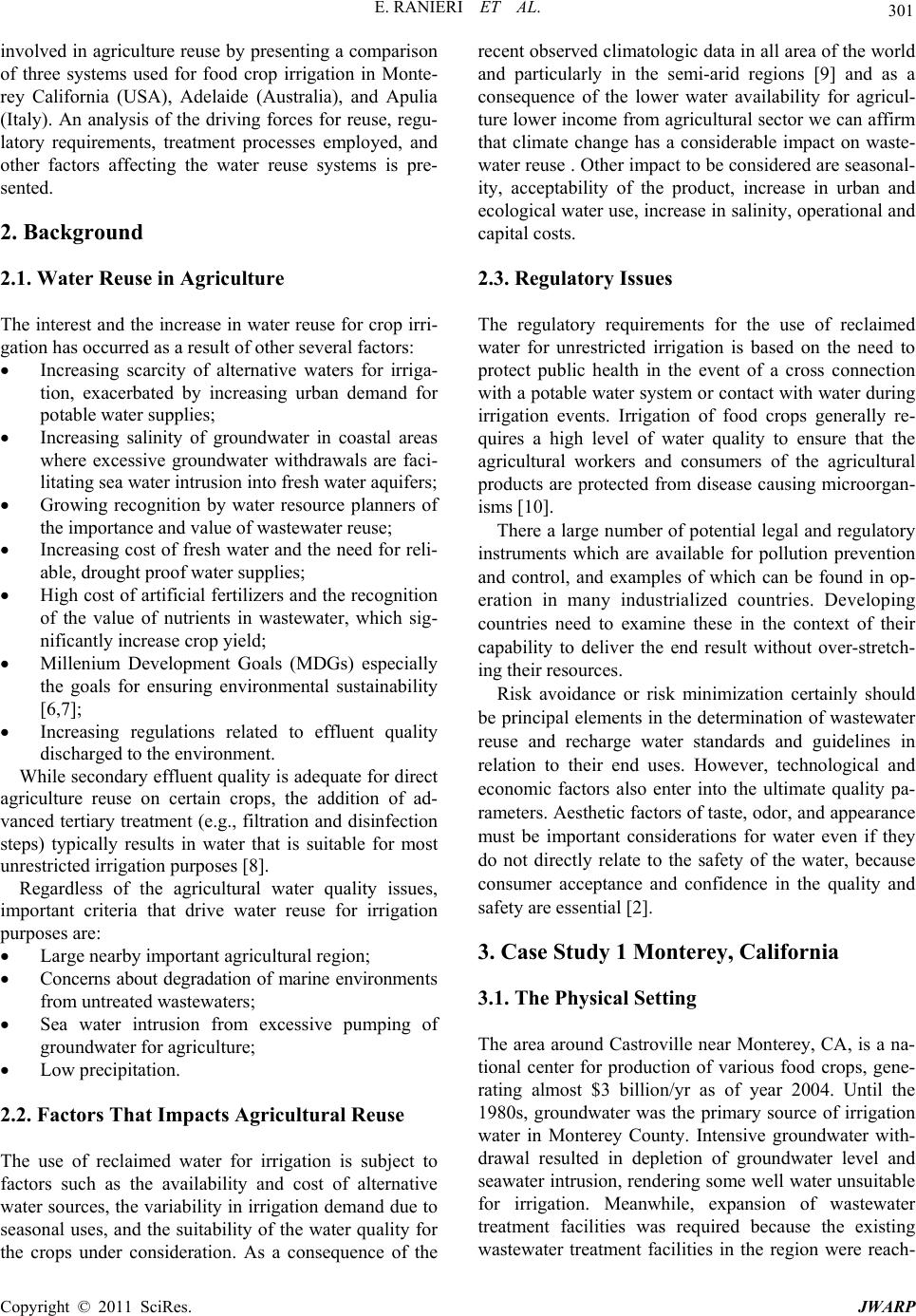 E. RANIERI ET AL. Copyright © 2011 SciRes. JWARP 301 involved in ag riculture reuse by presenting a comparison of three systems used for food crop irrigation in Monte- rey California (USA), Adelaide (Australia), and Apulia (Italy). An analysis of the driving forces for reuse, regu- latory requirements, treatment processes employed, and other factors affecting the water reuse systems is pre- sented. 2. Background 2.1. Water Reuse in Agriculture The interest and the increase in water reuse for crop irri- gation has occurred as a result of other several factors: Increasing scarcity of alternative waters for irriga- tion, exacerbated by increasing urban demand for potable water supp lies; Increasing salinity of groundwater in coastal areas where excessive groundwater withdrawals are faci- litating sea water intrusion into fresh water aquifers; Growing recognition by water resource planners of the importance and value of wastewater reuse; Increasing cost of fresh water and the need for reli- able, drought proof water supplies; High cost of artificial fertilizers and the recognition of the value of nutrients in wastewater, which sig- nificantly increase crop yield; Millenium Development Goals (MDGs) especially the goals for ensuring environmental sustainability [6,7]; Increasing regulations related to effluent quality discharged to the environment. While secondary effluent quality is adequate for direct agriculture reuse on certain crops, the addition of ad- vanced tertiary treatment (e.g., filtration and disinfection steps) typically results in water that is suitable for most unrestricted irrigation purposes [8]. Regardless of the agricultural water quality issues, important criteria that drive water reuse for irrigation purposes are: Large nearby important agricultural region; Concerns about degradation of marine environments from untreated wastewaters; Sea water intrusion from excessive pumping of groundwater for agriculture; Low precipitation. 2.2. Factors That Impacts Agricultural Reuse The use of reclaimed water for irrigation is subject to factors such as the availability and cost of alternative water sources, the variability in irrigation demand due to seasonal uses, and the suitability of the water quality for the crops under consideration. As a consequence of the recent observed climatologic data in all area of the world and particularly in the semi-arid regions [9] and as a consequence of the lower water availability for agricul- ture lower income from agricultural sector we can affirm that climate change has a considerable impact on waste- water reuse . Other impact to be considered are seasonal- ity, acceptability of the product, increase in urban and ecological water use, increase in salinity, op erational and capital costs. 2.3. Regulatory Issues The regulatory requirements for the use of reclaimed water for unrestricted irrigation is based on the need to protect public health in the event of a cross connection with a potable water system or contact with water during irrigation events. Irrigation of food crops generally re- quires a high level of water quality to ensure that the agricultural workers and consumers of the agricultural products are protected from disease causing microorgan- isms [10]. There a large number of potential legal and regulatory instruments which are available for pollution prevention and control, and examples of which can be found in op- eration in many industrialized countries. Developing countries need to examine these in the context of their capability to deliver the end result without over-stretch- ing their resources. Risk avoidance or risk minimization certainly should be principal elements in the determination of wastewater reuse and recharge water standards and guidelines in relation to their end uses. However, technological and economic factors also enter into the ultimate quality pa- rameters. Aesthetic factors of taste, odor, and appearance must be important considerations for water even if they do not directly relate to the safety of the water, because consumer acceptance and confidence in the quality and safety are essential [2]. 3. Case Study 1 Monterey, California 3.1. The Physical Setting The area around Castroville near Monterey, CA, is a na- tional center for production of various food crops, gene- rating almost $3 billion/yr as of year 2004. Until the 1980s, groundwater was the primary source of irrigation water in Monterey County. Intensive groundwater with- drawal resulted in depletion of groundwater level and seawater intrusion, rendering some well water unsuitable for irrigation. Meanwhile, expansion of wastewater treatment facilities was required because the existing wastewater treatment facilities in the region were reach-  E. RANIERI ET AL. Copyright © 2011 SciRes. JWARP 302 ing full capacity. Following the decision to pursu e irriga- tion of these food crops with reclaimed water, a 10-year study was conducted to assess the safety and feasibility of agricultural irrigation with reclaimed water [11]. 3.2. The Regulatory Setting The California Department of Health services (DHS) has established the wastewater reclamation criteria (State of California, 1978) known as title 22. The current Water Recycling Criteria were adopted by DHS in 2000 [12]. This water recycling criteria include water quality stan- dards. 3.3. Treatment Processes The wastewater reclamation plant was established in the early 1920s and subsequently modified and upgraded to include Title 22 process: coagulation, flocculation, sedi- mentation, filtration and chlorination. The process is shown on Figure 1. 4. Case Study 2 Adelaide, Australia 4.1. The Physical Setting In this dry agricultural coastal region (rainfall 600 mm/yr, evaporation 2 000 mm/yr), water availability is a li mi ting factor to crop production, and groundwater resources have been overdrawn for irrigation needs [13]. Consis- tent with a South Australia policy issued in 1993 to en- courage sustainable water reuse, and the 1995 Environ- mental Protection Act, further promoting and regulating water reuse, the City of Adelaide began considering rec- lamation and reuse of the Bolivar WWTP effluent to satisfy some seasonal irrigation demands, and reduce adverse ecological effects caused by nutrients discharged in the marine environment. Adelaide is perhaps the only industrialized city in the world to have constant problems of water shortage, b ecaus e its water supply depends up to 90% on Murray river. Beside aiming at providing rec- laimed water for agricultural use during peak demand in the summer time, and minimizing year-round nutrient loads to Gulf St Vincent, water reuse project also pre- sented an opportunity for generating economic benefits in the region, using taxpayer funds to both improve coastal water quality and promote agricultural production, rather than simply building a non-revenue generating nutrient removal upgrade to the Bolivar plant. To max- imize the economic goals, planners determined that rec- laimed water shou ld be stored during low demand season, thus increasing availability for summertime peak irriga- tion season. A multi-year research project was imple- mented to ensure that the treatment technology selected for production of the reclaimed water could be used to recharge the aquifer sustainably. 4.2. The Regulatory Setting The regulatory requirements are similar to the standards set in California for food crop irrigation and are also based on suitability to conduct ASR during the winter storage pe riod. 4.3. Treatment Processes The Bolivar Wastewater treatment plant treats 40 × 106 m3/yr and consists of primary sedimentation, secondary treat- ment using biological trickling filters and stabilization ponds prior the discharge in Gulf of St. Vincent, South Australia. In a second moment others treatments were added with the goal of recycling the treated water: dis- solved air flotation with filtration (DAFF) disinfection contact tank, balancing storage reservoir, as shown in Figure 2. Figure 1. Process flow diagram for Monterey regional water pollution control facility for production of water for unrestricted irrigation reuse. 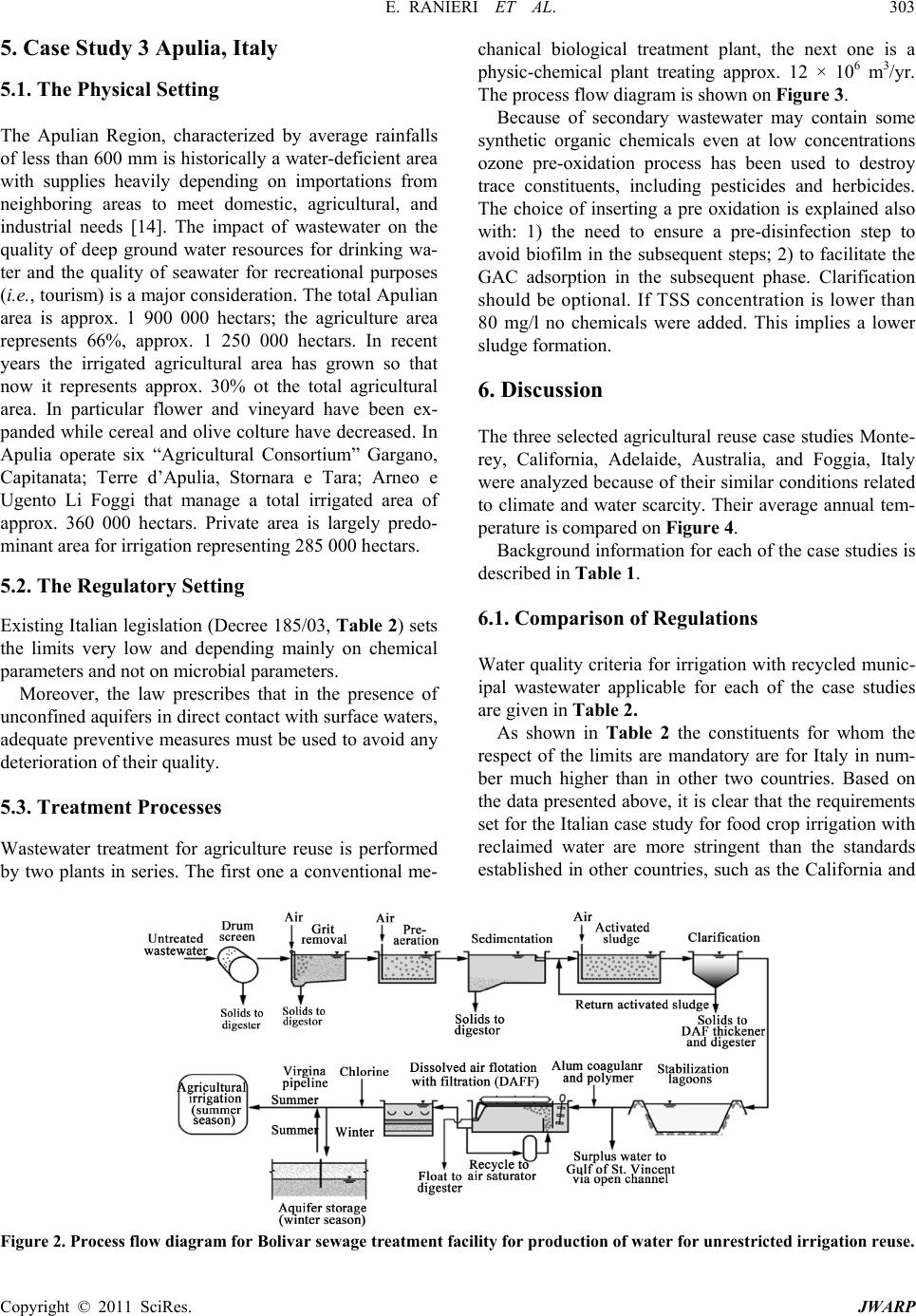 E. RANIERI ET AL. 303 Copyright © 2011 SciRes. JWARP 5. Case Study 3 Apulia, Italy 5.1. The Physical Setting The Apulian Region, characterized by average rainfalls of less than 600 mm is histo rically a water-deficient area with supplies heavily depending on importations from neighboring areas to meet domestic, agricultural, and industrial needs [14]. The impact of wastewater on the quality of deep ground water resources for drinking wa- ter and the quality of seawater for recreational purposes (i.e., tourism) is a major consideration. The total Apulian area is approx. 1 900 000 hectars; the agriculture area represents 66%, approx. 1 250 000 hectars. In recent years the irrigated agricultural area has grown so that now it represents approx. 30% ot the total agricultural area. In particular flower and vineyard have been ex- panded while cereal and olive colture have decreased. In Apulia operate six “Agricultural Consortium” Gargano, Capitanata; Terre d’Apulia, Stornara e Tara; Arneo e Ugento Li Foggi that manage a total irrigated area of approx. 360 000 hectars. Private area is largely predo- minant area for irrigat i on repres en ting 285 000 hectars. 5.2. The Regulatory Setting Existing Italian legislation (Decree 185/03, Table 2) sets the limits very low and depending mainly on chemical parameters and not on microbial parameters. Moreover, the law prescribes that in the presence of unconfined aquifers in direct contact with surface waters, adequate preventive measures must be used to avoid any deterioration of their quality. 5.3. Treatment Processes Wastewater treatment for agriculture reuse is performed by two plants in series. The first one a conventional me- chanical biological treatment plant, the next one is a physic-chemical plant treating approx. 12 × 106 m 3/yr. The process flow diagram is shown on Figure 3. Because of secondary wastewater may contain some synthetic organic chemicals even at low concentrations ozone pre-oxidation process has been used to destroy trace constituents, including pesticides and herbicides. The choice of inserting a pre oxidation is explained also with: 1) the need to ensure a pre-disinfection step to avoid biofilm in the subsequent steps; 2) to facilitate the GAC adsorption in the subsequent phase. Clarification should be optional. If TSS concentration is lower than 80 mg/l no chemicals were added. This implies a lower sludge fo rmation. 6. Discussion The three selected agricultural reuse case studies Monte- rey, California, Adelaide, Australia, and Foggia, Italy were analyzed because of their similar conditions related to climate and water scarcity. Their average annual tem- perature is compared on Figure 4. Background information for each of the case studies is described in Table 1. 6.1. Comparison of Regulations Water quality criteria for irrigation with recycled munic- ipal wastewater applicable for each of the case studies are given in Table 2. As shown in Table 2 the constituents for whom the respect of the limits are mandatory are for Italy in num- ber much higher than in other two countries. Based on the data presented above, it is clear that the requirements set for the Italian case study for food crop irrigation with reclaimed water are more stringent than the standards established in other countries, such as the California and Figure 2. Process flow diagram for Bolivar sewage treatment facility for production of water for unrestricted irrigation reuse.  E. RANIERI ET AL. Copyright © 2011 SciRes. JWARP 304 Figure 3. Process flow diagram for the Foggia wastewater reclamation facility for production of water for unrestricted irriga- tion reuse. Figure 4. Average temperature in Foggia, Adelaide, Monterey during the year. Table 1. Summary of irrigated area and water use. Region Volume of recycled water used for irrig a tion, m3/yr Percent of flow treated used for irrigation Irrigated area with recycled water, ha Management of non-irrigat ion water Typical Irrigated crops Monterey 25 000 000 85 4 700 Discharge to Pacific Ocean artichokes, brassicas, strawberries, salad crops Adelaide 280 000 000 100 20 000 Discharge to sea and/or aquifer sto- rage and recovery vineyards, olive trees, salad crops, brassicas Apulia 12 000 000 20 4 000 Discharge to canals leading to Adriatic Sea vineyards, olive & peach trees, artichokes Australia. In California more importance is given to the-microbiology of the water and it should be noted that  E. RANIERI ET AL. Copyright © 2011 SciRes. JWARP 305 also Italy regulation should be performed in that way, because of E.coli is the unique microbiological parame- ter and should not perform the total microbiological quality of water. The surface water supplies currently used for the w ater supply of Southern Italy would not be able to meet the standards established for the reclaimed water. Thus, the standard may be considered overly restrictive for the water reuse application in question. In California and Australia, standards for many con- stituents are provided as a guideline, not as a set limit and, therefore, not limiting the implementation of water reuse projects unnecessarily. Several factors or percep- tions that may have contributed to the development of these standards include: Table 2. Selected water quality for food crop irrigation. Parameter Unit California Apulia, Italy Southern Australia pH 6 – 9.5 4.5 – 9.0 SAR 10 2 - 102a TSS mg/L NS 10 Turbidity NTU < 2 < 2 BOD5 mg/L NS 20 COD mg/L 100 Phosphorus, tota l mg/L 2 Nitrogen, total mg/L 15 Nitrogen, ammonium mg/L 2 Conductivity mg/L 3000 Metals mg/L Aluminum mg/L 1 5 Arsenic mg/L 0.1 0.02 0.1 Cadmium mg/L 0.01 0.005 0.01 Chromium mg/L 0.1 0.1 1 Iron mg/L 2 1 Lead mg/L 5 0.1 0.2 Mercury mg/L 0.01 0.001 0.002 Selenium mg/L 0.02 0.01 0.02 Zinc mg/L 2 0.5 2 Mineral oils mg/L 0.5 Total phenols mg/L 0.1 Total surfactants mg/L 0.5 THMs (sum) mg/L 0.03 Total chlorinated solvents mg/L 0.04 Benzo (a) pyrene mg/L 0.00001 Total pesticides mg/L 0.5 Aromatic Nitrogen S o l v e n t s mg/L 0.01 Benzene mg/L 0.001 Pentachlorophenol mg/L 0.003 Total coliform No./100 mL 2.2 (7 d med) 23 (30 d max) Fecal coliform (or E. coli) No./100 mL < 10 E. coli No./100 mL 10 (80%) 100 (max) Specific pathogens May be required aGuideline depending on crop sensitivity; bPhysical or chemical processing sufficient to destroy pathogenic microorganisms. Less restrictive requirements may apply wh ere there is no direct contact bet ween recl aimed wat er and t he edibl e portion of the crop ; c Food cr ops eaten raw where t here is di rect contact between reclaimed water and the edible portion of the crop. 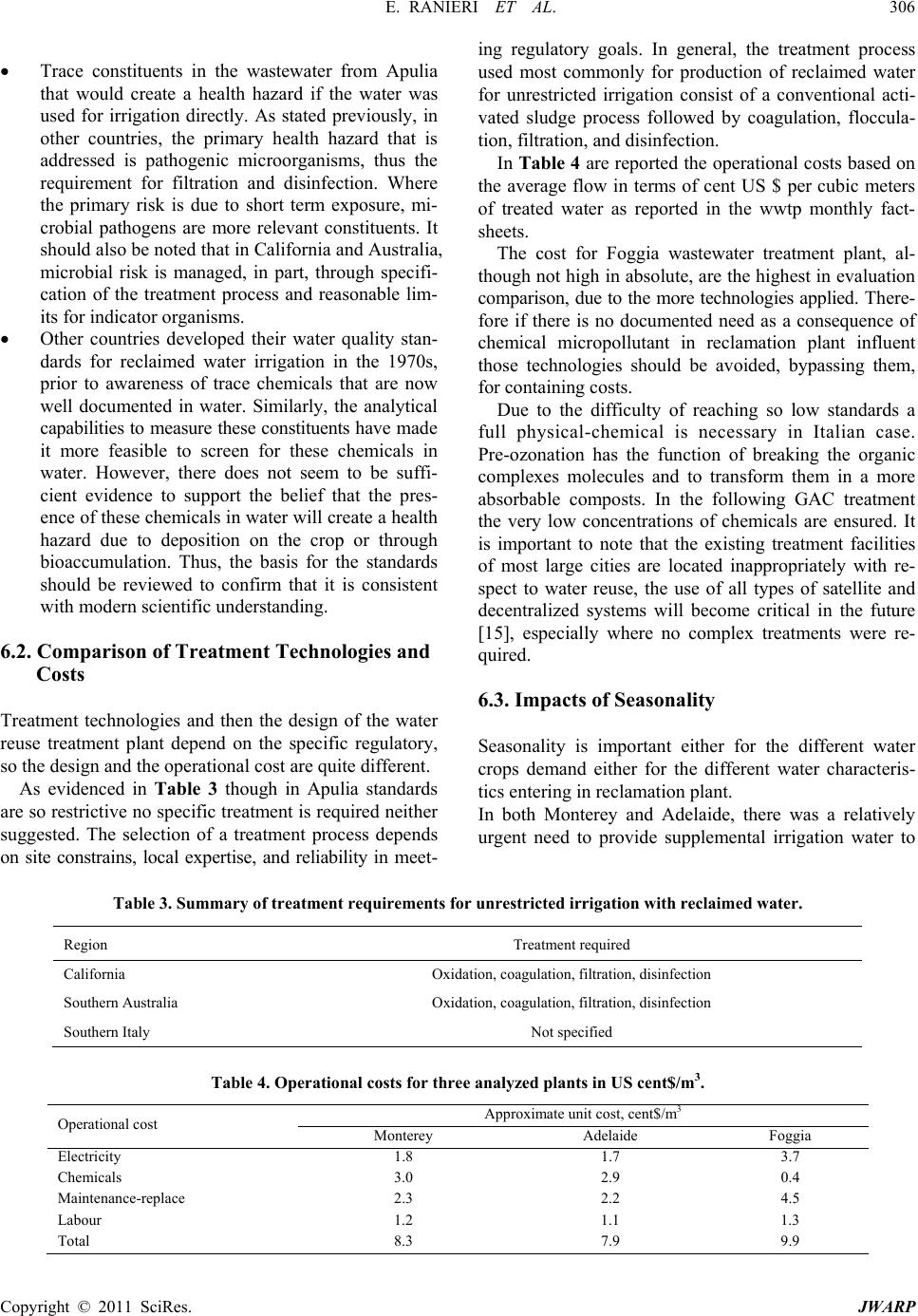 E. RANIERI ET AL. 306 Copyright © 2011 SciRes. JWARP Trace constituents in the wastewater from Apulia that would create a health hazard if the water was used for irrigation directly. As stated previously, in other countries, the primary health hazard that is addressed is pathogenic microorganisms, thus the requirement for filtration and disinfection. Where the primary risk is due to short term exposure, mi- crobial pathogens are more relevant constituents. It should also be noted that in California and Australia, microbial risk is managed, in part, through specifi- cation of the treatment process and reasonable lim- its for indicator organisms. Other countries developed their water quality stan- dards for reclaimed water irrigation in the 1970s, prior to awareness of trace chemicals that are now well documented in water. Similarly, the analytical capabilities to measure these constituents have made it more feasible to screen for these chemicals in water. However, there does not seem to be suffi- cient evidence to support the belief that the pres- ence of these chemicals in water will create a health hazard due to deposition on the crop or through bioaccumulation. Thus, the basis for the standards should be reviewed to confirm that it is consistent with modern scientific understanding. 6.2. Comparison of Treatment Technologies and Costs Treatment technologies and then the design of the water reuse treatment plant depend on the specific regulatory, so the design and the operational cost are quite different. As evidenced in Table 3 though in Apulia standards are so restrictive no specific treatment is required neither suggested. The selection of a treatment process depends on site constrains, local expertise, and reliability in meet- ing regulatory goals. In general, the treatment process used most commonly for production of reclaimed water for unrestricted irrigation consist of a conventional acti- vated sludge process followed by coagulation, floccula- tion, filtration, and disinfection. In Ta ble 4 are reported the operational costs based on the average flow in terms of cent US $ per cubic meters of treated water as reported in the wwtp monthly fact- sheets. The cost for Foggia wastewater treatment plant, al- though not high in ab solute, are the highest in evaluation comparison, due to the more technologies applied. There- fore if there is no documented need as a consequence of chemical micropollutant in reclamation plant influent those technologies should be avoided, bypassing them, for containing costs. Due to the difficulty of reaching so low standards a full physical-chemical is necessary in Italian case. Pre-ozonation has the function of breaking the organic complexes molecules and to transform them in a more absorbable composts. In the following GAC treatment the very low concentrations of chemicals are ensured. It is important to note that the existing treatment facilities of most large cities are located inappropriately with re- spect to water reuse, the use of all types of satellite and decentralized systems will become critical in the future [15], especially where no complex treatments were re- quired. 6.3. Impacts of Seasonality Seasonality is important either for the different water crops demand either for the different water characteris- tics entering in reclamation plant. In both Monterey and Adelaide, there was a relatively urgent need to provide supplemental irrigation water to Table 3. Summary of treatment requirements for unrestricted irrigation with reclaimed water. Region Treatment required California Oxidation, coagulation, filtration, disinfection Southern Australia Oxidation, coagulation, filtration, disinfection Southern Italy Not specified Table 4. Operational costs for three analyzed plants in US cent$/m3. Operational cost Approximate unit cost, cent$/m3 Monterey Adelaide Foggia Electricity 1.8 1.7 3.7 Chemicals 3.0 2.9 0.4 Maintenance-replace 2.3 2.2 4.5 Labour 1.2 1.1 1.3 Total 8.3 7.9 9.9 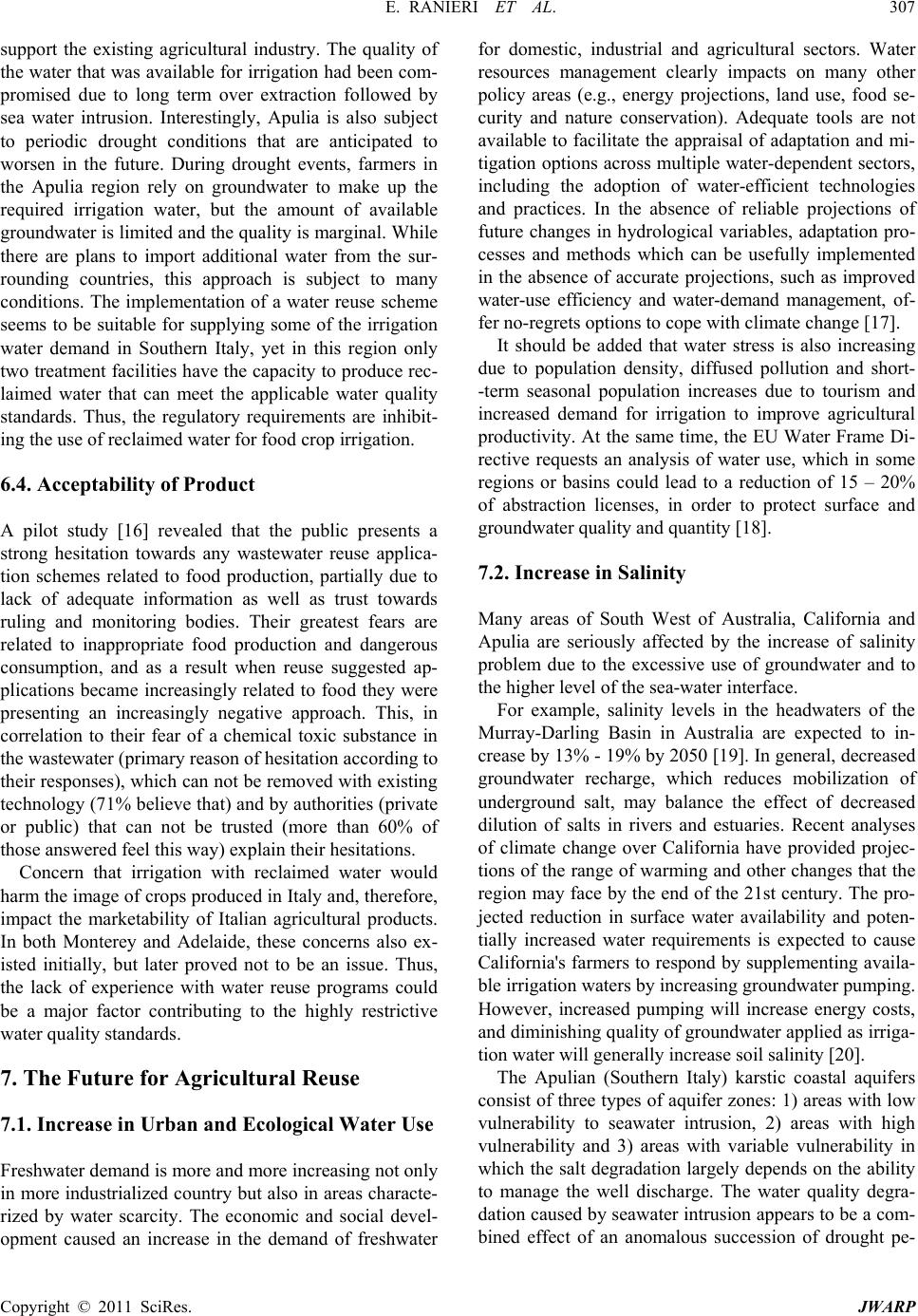 E. RANIERI ET AL. 307 Copyright © 2011 SciRes. JWARP support the existing agricultural industry. The quality of the water that was available for irrigation had been com- promised due to long term over extraction followed by sea water intrusion. Interestingly, Apulia is also subject to periodic drought conditions that are anticipated to worsen in the future. During drought events, farmers in the Apulia region rely on groundwater to make up the required irrigation water, but the amount of available groundwater is limited and the quality is marginal. While there are plans to import additional water from the sur- rounding countries, this approach is subject to many conditions. The implementation of a water reuse scheme seems to be suitable for supplying some of the irrigation water demand in Southern Italy, yet in this region only two treatment facilities have the capacity to produce rec- laimed water that can meet the applicable water quality standards. Thus, the regulatory requirements are inhibit- ing the use of reclaimed water for food crop irrigation. 6.4. Acceptability of Product A pilot study [16] revealed that the public presents a strong hesitation towards any wastewater reuse applica- tion schemes related to food production, partially due to lack of adequate information as well as trust towards ruling and monitoring bodies. Their greatest fears are related to inappropriate food production and dangerous consumption, and as a result when reuse suggested ap- plications became increasingly related to food they were presenting an increasingly negative approach. This, in correlation to their fear of a chemical toxic substance in the wastewater (primary reason of hesitation according to their responses), which can not be removed with existing technology (71% believe that) and by authorities (private or public) that can not be trusted (more than 60% of those answered feel this way) explain their hesitations. Concern that irrigation with reclaimed water would harm the image of crops produced in Italy and, therefore, impact the marketability of Italian agricultural products. In both Monterey and Adelaide, these concerns also ex- isted initially, but later proved not to be an issue. Thus, the lack of experience with water reuse programs could be a major factor contributing to the highly restrictive water quality standards. 7. The Future for Agricultural Reuse 7.1. Increase in Urban and Ecological Water Use Freshwater demand is more and more increasing not only in more industrialized country but also in areas characte- rized by water scarcity. The economic and social devel- opment caused an increase in the demand of freshwater for domestic, industrial and agricultural sectors. Water resources management clearly impacts on many other policy areas (e.g., energy projections, land use, food se- curity and nature conservation). Adequate tools are not available to facilitate the appraisal of adaptation and mi- tigation options across multiple water-dependent sectors, including the adoption of water-efficient technologies and practices. In the absence of reliable projections of future changes in hydrological variables, adaptation pro- cesses and methods which can be usefully implemented in the absence of accurate projections, such as improved water-use efficiency and water-demand management, of- fer no-regrets options to cope with climate change [17]. It should be added that water stress is also increasing due to population density, diffused pollution and short- -term seasonal population increases due to tourism and increased demand for irrigation to improve agricultural productivity. At the same time, the EU Water Frame Di- rective requests an analysis of water use, which in some regions or basins could lead to a reduction of 15 – 20% of abstraction licenses, in order to protect surface and groundwater quality and quantity [18]. 7.2. Increase in Salinity Many areas of South West of Australia, California and Apulia are seriously affected by the increase of salinity problem due to the excessive use of groundwater and to the higher level of the sea-water interface. For example, salinity levels in the headwaters of the Murray-Darling Basin in Australia are expected to in- crease by 13% - 19% by 2050 [19]. In general, decreased groundwater recharge, which reduces mobilization of underground salt, may balance the effect of decreased dilution of salts in rivers and estuaries. Recent analyses of climate change over California have provided projec- tions of the range of warming and other changes that the region may face by the end of the 21st century. The pro- jected reduction in surface water availability and poten- tially increased water requirements is expected to cause California's far mers to respond b y supplementing availa- ble irrigation wate rs by incre a si ng gr o un d w at er pumping. However, increased pumping will increase energy costs, and diminishing quality of groundwater ap plied as irriga- tion water will generally increase soil salinity [20]. The Apulian (Southern Italy) karstic coastal aquifers consist of three types of aquifer zones: 1) areas with low vulnerability to seawater intrusion, 2) areas with high vulnerability and 3) areas with variable vulnerability in which the salt degradation largely depends on the ability to manage the well discharge. The water quality degra- dation caused by seawater intrusion appears to be a com- bined effect of an anomalous succession of drought pe- 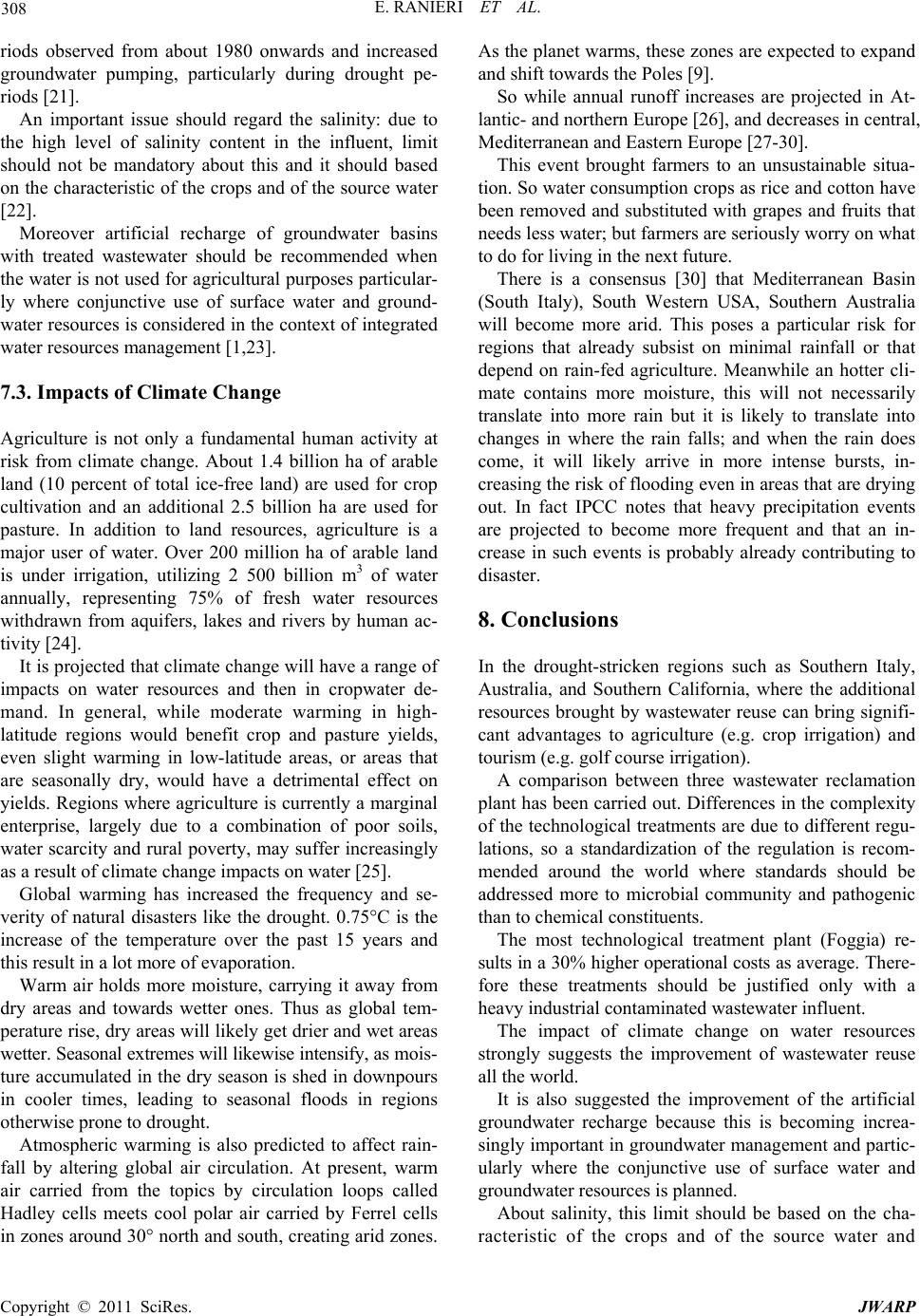 E. RANIERI ET AL. Copyright © 2011 SciRes. JWARP 308 riods observed from about 1980 onwards and increased groundwater pumping, particularly during drought pe- riods [21]. An important issue should regard the salinity: due to the high level of salinity content in the influent, limit should not be mandatory about this and it should based on the characteristic of the crops and of the source water [22]. Moreover artificial recharge of groundwater basins with treated wastewater should be recommended when the water is not used for agricultural purposes particular- ly where conjunctive use of surface water and ground- water resources is considered in th e context of integrated water resource s m a nagement [1,23]. 7.3. Impacts of Climate Change Agriculture is not only a fundamental human activity at risk from climate change. About 1.4 billion ha of arable land (10 percent of total ice-free land) are used for crop cultivation and an additional 2.5 billion ha are used for pasture. In addition to land resources, agriculture is a major user of water. Over 200 million ha of arable land is under irrigation, utilizing 2 500 billion m3 of water annually, representing 75% of fresh water resources withdrawn from aquifers, lakes and rivers by human ac- tivity [24]. It is projected that climate change will have a range of impacts on water resources and then in cropwater de- mand. In general, while moderate warming in high- latitude regions would benefit crop and pasture yields, even slight warming in low-latitude areas, or areas that are seasonally dry, would have a detrimental effect on yields. Regions where agriculture is currently a marginal enterprise, largely due to a combination of poor soils, water scarcity and rural poverty, may suffer increasingly as a result of climate change impacts on water [25]. Global warming has increased the frequency and se- verity of natural disasters like the drought. 0.75°C is the increase of the temperature over the past 15 years and this result in a lot more of evap oration. Warm air holds more moisture, carrying it away from dry areas and towards wetter ones. Thus as global tem- perature rise, dry areas will likely get drier an d wet areas wetter. Seasonal extremes will l ikewise inten sify, as mois - ture accumulated in the dry season is shed in downpours in cooler times, leading to seasonal floods in regions otherwise prone to drought. Atmospheric warming is also predicted to affect rain- fall by altering global air circulation. At present, warm air carried from the topics by circulation loops called Hadley cells meets cool polar air carried by Ferrel cells in zones around 30° no rth and south, creating arid zones. As the planet warms, these zones are expected to expand and shift towards the Poles [9]. So while annual runoff increases are projected in At- lantic- and northern Europe [26], and decreases in central, Mediterranean and Eastern Europe [27- 30]. This event brought farmers to an unsustainable situa- tion. So water consumption crops as rice and cotton have been removed and substituted with grapes and fruits that needs less water; but farmers are seriously worry on what to do for living in the next future. There is a consensus [30] that Mediterranean Basin (South Italy), South Western USA, Southern Australia will become more arid. This poses a particular risk for regions that already subsist on minimal rainfall or that depend on rain-fed agriculture. Meanwhile an hotter cli- mate contains more moisture, this will not necessarily translate into more rain but it is likely to translate into changes in where the rain falls; and when the rain does come, it will likely arrive in more intense bursts, in- creasing the risk of flooding even in areas that are drying out. In fact IPCC notes that heavy precipitation events are projected to become more frequent and that an in- crease in such events is probably already contributing to disaster. 8. Conclusions In the drought-stricken regions such as Southern Italy, Australia, and Southern California, where the additional resources brought by wastewater reuse can bring signifi- cant advantages to agriculture (e.g. crop irrigation) and tourism (e.g. golf course irrigation). A comparison between three wastewater reclamation plant has been carried out. Differences in the complexity of the technological treatments are due to different regu- lations, so a standardization of the regulation is recom- mended around the world where standards should be addressed more to microbial community and pathogenic than to chemical constituents. The most technological treatment plant (Foggia) re- sults in a 30% higher operational costs as average. The re- fore these treatments should be justified only with a heavy industrial contaminated wastewater influent. The impact of climate change on water resources strongly suggests the improvement of wastewater reuse all the world. It is also suggested the improvement of the artificial groundwater recharge because this is becoming increa- singly important in groundwater management and partic- ularly where the conjunctive use of surface water and groundwater resources is planned. About salinity, this limit should be based on the cha- racteristic of the crops and of the source water and 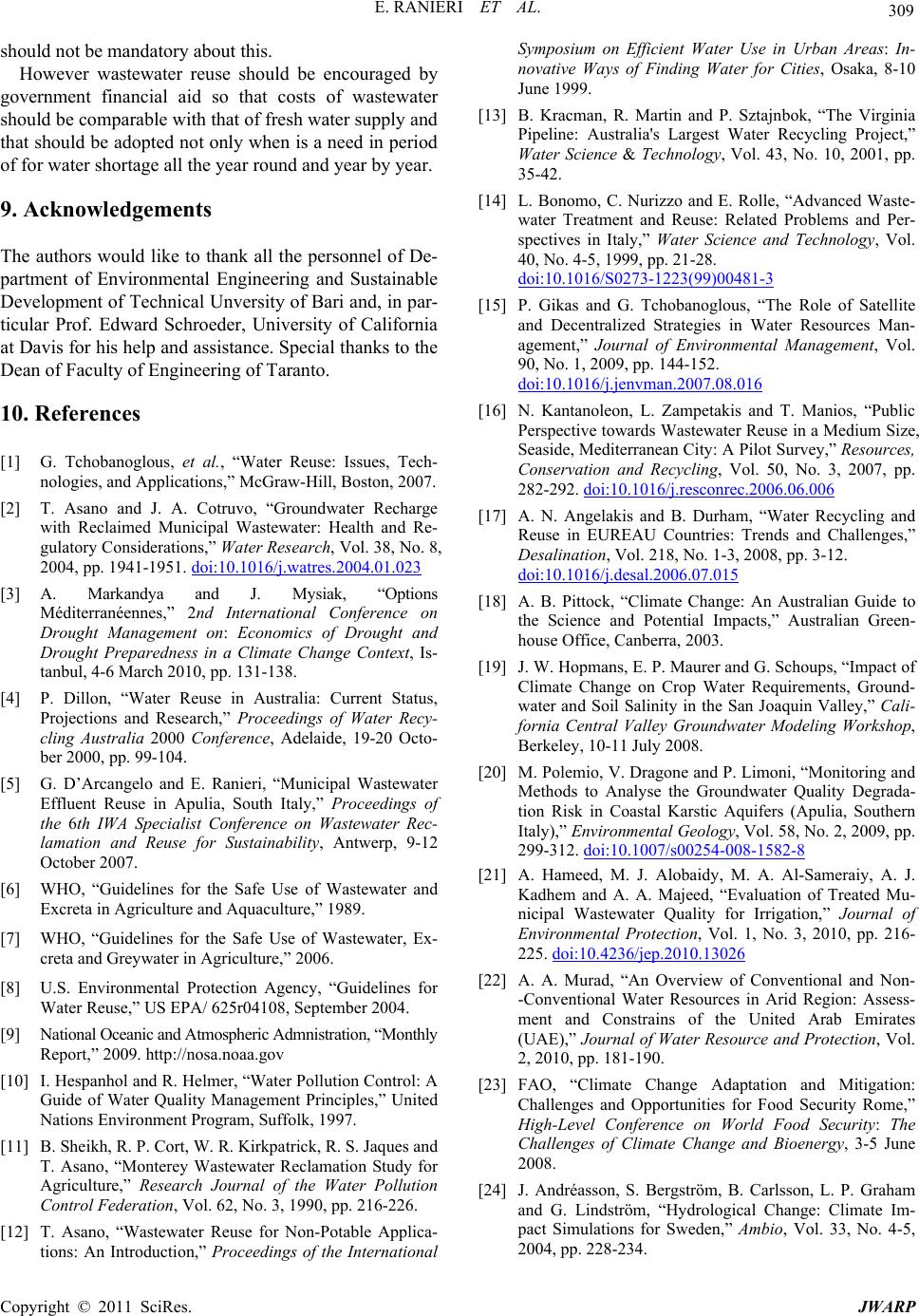 E. RANIERI ET AL. Copyright © 2011 SciRes. JWARP 309 should not be ma ndat o ry abo ut thi s. However wastewater reuse should be encouraged by government financial aid so that costs of wastewater should be comparab le with that of fresh water supply and that should b e adopted not only when is a need in period of for water shortage all the year round and year by year. 9. Acknowledgements The authors would like to thank all the personnel of De- partment of Environmental Engineering and Sustainable Development of Technical Unversity of Bari and, in par- ticular Prof. Edward Schroeder, University of California at Davis for his help and assistance. Special thanks to the Dean of Faculty of Engineering of Taranto. 10. References [1] G. Tchobanoglous, et al., “Water Reuse: Issues, Tech- nologies, and Applications,” McGraw-Hill, Boston, 2007. [2] T. Asano and J. A. Cotruvo, “Groundwater Recharge with Reclaimed Municipal Wastewater: Health and Re- gulatory Considerations,” Water Research, Vol. 38, No. 8, 2004, pp. 1941-1951. doi:10.1016/j.watres.2004.01.023 [3] A. Markandya and J. Mysiak, “Options Méditerranéennes,” 2nd International Conference on Drought Management on: Economics of Drought and Drought Preparedness in a Climate Change Context, Is- tanbul, 4-6 March 2010, pp. 131-138. [4] P. Dillon, “Water Reuse in Australia: Current Status, Projections and Research,” Proceedings of Water Recy- cling Australia 2000 Conference, Adelaide, 19-20 Octo- ber 2000, pp. 99-104. [5] G. D’Arcangelo and E. Ranieri, “Municipal Wastewater Effluent Reuse in Apulia, South Italy,” Proceedings of the 6th IWA Specialist Conference on Wastewater Rec- lamation and Reuse for Sustainability, Antwerp, 9-12 October 2007. [6] WHO, “Guidelines for the Safe Use of Wastewater and Excreta in Agriculture and Aquaculture,” 1989. [7] WHO, “Guidelines for the Safe Use of Wastewater, Ex- creta and Greywater in Agriculture,” 2006. [8] U.S. Environmental Protection Agency, “Guidelines for Water Reuse,” US EPA/ 625r04108, September 2004. [9] National Oceanic and Atmospheric Admnistration, “Monthly Report,” 2009. http://nosa.noaa.gov [10] I. Hespanhol and R. Helmer, “Water Pollution Control: A Guide of Water Quality Management Principles,” United Nations Environment Program, Suffolk, 1997. [11] B. Sheikh, R. P. Cort, W. R. Kirkpatrick, R. S. Jaques and T. Asano, “Monterey Wastewater Reclamation Study for Agriculture,” Research Journal of the Water Pollution Control Federation, Vol. 62, No. 3, 1990, pp. 216-226. [12] T. Asano, “Wastewater Reuse for Non-Potable Applica- tions: An Introduction,” Proceedings of the International Symposium on Efficient Water Use in Urban Areas: In- novative Ways of Finding Water for Cities, Osaka, 8-10 June 1999. [13] B. Kracman, R. Martin and P. Sztajnbok, “The Virginia Pipeline: Australia's Largest Water Recycling Project,” Water Science & Technology, Vol. 43, No. 10, 2001, pp. 35-42. [14] L. Bonomo, C. Nurizzo and E. Rolle, “Advanced Waste- water Treatment and Reuse: Related Problems and Per- spectives in Italy,” Water Science and Technology, Vol. 40, No. 4-5, 1999, pp. 21-28. doi:10.1016/S0273-1223(99)00481-3 [15] P. Gikas and G. Tchobanoglous, “The Role of Satellite and Decentralized Strategies in Water Resources Man- agement,” Journal of Environmental Management, Vol. 90, No. 1, 2009, pp. 144-152. doi:10.1016/j.jenvman.2007.08.016 [16] N. Kantanoleon, L. Zampetakis and T. Manios, “Public Perspective towards Wastewater Reuse in a Medium Size, Seaside, Mediterranean City: A Pilot Survey,” Resources, Conservation and Recycling, Vol. 50, No. 3, 2007, pp. 282-292. doi:10.1016/j.resconrec.2006.06.006 [17] A. N. Angelakis and B. Durham, “Water Recycling and Reuse in EUREAU Countries: Trends and Challenges,” Desalination, Vol. 218, No. 1-3, 2008, pp. 3-12. doi:10.1016/j.desal.2006.07.015 [18] A. B. Pittock, “Climate Change: An Australian Guide to the Science and Potential Impacts,” Australian Green- house Office, Canberra, 2003. [19] J. W. Hopmans, E. P. Maurer and G. Schoups, “Impact of Climate Change on Crop Water Requirements, Ground- water and Soil Salinity in the San Joaquin Valley,” Cali- fornia Central Valley Groundwater Modeling Workshop, Berkeley, 10-11 July 2008. [20] M. Polemio, V. Dragone and P. Limoni, “Monitoring and Methods to Analyse the Groundwater Quality Degrada- tion Risk in Coastal Karstic Aquifers (Apulia, Southern Italy),” Environmental Geology, Vol. 58, No. 2, 2009, pp. 299-312. doi:10.1007/s00254-008-1582-8 [21] A. Hameed, M. J. Alobaidy, M. A. Al-Sameraiy, A. J. Kadhem and A. A. Majeed, “Evaluation of Treated Mu- nicipal Wastewater Quality for Irrigation,” Journal of Environmental Protection, Vol. 1, No. 3, 2010, pp. 216- 225. doi:10.4236/jep.2010.13026 [22] A. A. Murad, “An Overview of Conventional and Non- -Conventional Water Resources in Arid Region: Assess- ment and Constrains of the United Arab Emirates (UAE),” Journal of Water Resource and Protection, Vol. 2, 2010, pp. 181-190. [23] FAO, “Climate Change Adaptation and Mitigation: Challenges and Opportunities for Food Security Rome,” High-Level Conference on World Food Security: The Challenges of Climate Change and Bioenergy, 3-5 June 2008. [24] J. Andréasson, S. Bergström, B. Carlsson, L. P. Graham and G. Lindström, “Hydrological Change: Climate Im- pact Simulations for Sweden,” Ambio, Vol. 33, No. 4-5, 2004, pp. 228-234.  E. RANIERI ET AL. Copyright © 2011 SciRes. JWARP 310 [25] IPCC Intergovernmental Panel on Climate Change, “Cli- mate Change and Water Technical Paper VI,” June 2008. [26] H. Chang, C. G. Knight, M. P. Staneva and D. Kostov, “Water Resource Impacts of Climate Change in South- western Bulgaria,” GeoJournal, Vol. 57, No. 3, 2002, pp. 159-168. doi:10.1023/B:GEJO.0000003611.11187.5c [27] P. Etchevers, C. Golaz, F. Habets and J. Noilhan, “Impact of a Climate Change on the Rhone River Catchment Hy- drology,” Journal of Geophysical Research, Vol. 107, No. D16, 2002, p. 4293. 10.1029/2001JD000490 [28] L. Menzel and G. Bürger, “Climate Change Scenarios and Runoff Response in the Mulde Catchment (Southern Elbe, Germany),” Journal of Hydrology, Vol. 267, No. 1-2, 2002, pp. 53-64. doi:10.1016/S0022-1694(02)00139-7 [29] A. Iglesias, T. Estrela and F. Gallart, “Impactos Sobre los Recursos Hídricos,” In: J. M. Moreno, Ed., Evaluación Preliminar de los Impactos en España for Efecto del Cambio Climático, Ministerio de Medio Ambiente, Ma- drid, 2005, pp. 303-353. [30] Interenvironment Institute, “The Malibu Declaration: Cities and Conservation in Mediterranean-Type Ecosys- tems,” Proceedings of Workshop: Design an Interconti- nental Program on Cities and Conservation in Mediter- ranean-Type Ecosystems, Malibu, 21-24 March 2004. |

